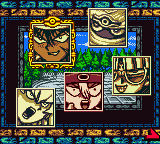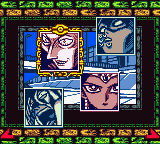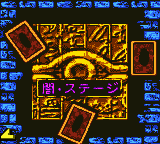Difference between revisions of "Yu-Gi-Oh! Duel Monsters 4: Battle of Great Duelist"
(→Changes from Duel Monsters III) |
(→Game options) |
||
| Line 107: | Line 107: | ||
===Versus=== | ===Versus=== | ||
| + | Players can battle other players with a copy of ''Yu-Gi-Oh! Duel Monsters 4'' using the [[wikipedia:Game Link Cable|Game Link Cable]] via the versus menu. The Deck can be altered, and a Deck Capacity limit can be chosen, on this screen. Allowed limits are 500, 700, 1000, 2000 and 9999. | ||
===Password=== | ===Password=== | ||
| Line 146: | Line 147: | ||
|} | |} | ||
| − | === | + | ===Records=== |
| + | The records screen contains the player's communication battle statistics, Duelist Level, Deck Volume and statistics for campaign-mode opponents. | ||
===Trade=== | ===Trade=== | ||
| − | + | From the trade menu, the player can trade cards with other copies of ''[[Yu-Gi-Oh! Duel Monsters 4: Battle of Great Duelist]]'', using the [[wikipedia:Game Link Cable|Game Link Cable]]. | |
| − | |||
==Obtaining cards== | ==Obtaining cards== | ||
Revision as of 15:52, 24 March 2019
| Yu-Gi-Oh! Duel Monsters 4: Battle of Great Duelist | |
|---|---|
| 300px 300px | |
| English | Yu-Gi-Oh! Duel Monsters 4: Battle of Great Duelist |
| Kanji | 遊戯王デュエルモンスターズ4 |
| Romaji | Yūgiō Dyueru Monsutāzu 4 Batoru obu Gureito Dyuerisuto |
| Developer(s) | Konami |
| Publisher(s) | Konami |
| Platform(s) | Game Boy Color |
| Release date(s) |
|
| Genre(s) | Card Battle |
| Related Galleries | Card gallery |
Yu-Gi-Oh! Duel Monsters 4: Battle of Great Duelist (遊戯王デュエルモンスターズ4
Each of the god cards are usable after completing the game, but they can only be obtained from a different version by trading:
- Slifer the Sky Dragon can be used in the Yugi Deck version, obtained in the Kaiba Deck version by defeating Yami Yugi.
- Obelisk the Tormentor can be used in the Kaiba Deck version, obtained in the Jonouchi Deck version by defeating Yami Bakura.
- The Winged Dragon of Ra can be used in the Jonouchi Deck version, obtained in the Yugi Deck version by defeating Marik.
Contents
Changes from Duel Monsters III
General
- Three versions of the game were released simultaneously; Yugi Deck, Kaiba Deck and Joey Deck. Each version has access to features not available in all three.
- Card construction has been removed. However a few of the cards which could be formed by construction are available as regular cards.
- The ability to name the player has been removed.
Campaign
- The opponent Strings is added. Bandit Keith and Maximillion Pegasus, who were present in Duel Monsters 2, but not Duel Monsters 3 have been re-added.
- Tristan, Joey, Yugi, Kaiba, Seto, Heishin, DarkNite/Nitemare and Shadi are not available as opponents.
- The stages certain opponents appear in are changed.
- Opponents' Decks and cards dropped are changed.
Rules
- Some cards can only be used in specific versions of the game. e.g. "B.eye White Dragon" can only be used in the Kaiba Deck version.
- 3 offerings are required to Summon Level 9 or higher monsters. While previous games featured Level 9 and higher monsters, legitimate copies could not be included in a Deck. If a player managed to include a copy in their Deck in a previous game, only two offerings would have been required to Summon it.
- The Graveyard mechanic is introduced. In previous games, it was not possible to interact with cards after they had been destroyed or used.
- Trap Cards remain on the field until they are activated. Previously, they would disappear if they were not triggered on the opponent's next turn.
Cards
- The Levels of many cards are changed, with Levels generally being based on ATK and DEF:
- Level 1 to 4: Anything with less than 1400 ATK and DEF.
- Level 5 to 6: Anything with either an ATK or DEF of at least 1400 and both ATK and DEF less than or equal to 2000.
- Level 7 to 8: Anything with either an ATK or DEF greater than 2000 and both ATK and DEF less than 2800.
- Level 9 to 12: Anything with either an ATK or DEF of at least 2800.
Other
- Passwords can be used to unlock two opponents, who are faced outside of the campaign menu; Gonbutori and Kaiser UmiUma.
Cards
Game options
The following options are available from the main menu:
- Campaign (キャンペーン kyanpēn): the game's story mode. Face AI opponents.
- Versus (たいせん taisen): battle other players, using the Game Link Cable
- Password (パスワード pasuwādo): unlock items by entering a password
- Records (せいせき seiseki): statistics and other information about the player
- Trade (トレード torēdo): trade with other players via the Game Link Cable.
Campaign
Each opponent in a stage must be defeated 5 times to unlock the next stage. After this, opponents can continue to be battled for more points and card drops. The Stage 4 opponent is changed with a password. Mai Valentine is the default Stage 4 opponent.
| Opponents | Image |
|---|---|
| Stage 1 | |

| |
| Stage 2 | |

| |
| Stage 3 | |

| |
| Stage 4 | |

| |
Versus
Players can battle other players with a copy of Yu-Gi-Oh! Duel Monsters 4 using the Game Link Cable via the versus menu. The Deck can be altered, and a Deck Capacity limit can be chosen, on this screen. Allowed limits are 500, 700, 1000, 2000 and 9999.
Password
Cards can be added to the player's chest in the password menu, by entering eight-digit passwords from OCG/TCG cards. There are a few non-card passwords used to unlock other features.
| Password | Action |
|---|---|
| 17232574 | Grandpa gives the player an extra card after each Duel |
| 71837829 | Change the Stage 4 opponent to Mai Valentine |
| 45442120 | Change the Stage 4 opponent to Bandit Keith |
| 82659417 | Change the Stage 4 opponent to Yami Bakura |
| 45565702 | Change the Stage 4 opponent to Marik Ishtar |
| 18054115 | Change the Stage 4 opponent to Yami Yugi |
| 19170603 | Battle Gonbutori |
| 83771069 | Battle Kaiser UmiUma |
| 44220672 | View the credits |
Records
The records screen contains the player's communication battle statistics, Duelist Level, Deck Volume and statistics for campaign-mode opponents.
Trade
From the trade menu, the player can trade cards with other copies of Yu-Gi-Oh! Duel Monsters 4: Battle of Great Duelist, using the Game Link Cable.
Obtaining cards
Temporarily obtaining cards
Fusion Summon
Since "Polymerization" is not included in this game, Fusions occur differently; selecting one card and placing it on top of another compatible card could result in a fusion for an entirely different monster.
These Fusions are Alignment-based and are reflected as such in the combination they create. For instance, fusing "Thunder Kid" with "Yamatano Dragon Scroll" would result in "Thunder Dragon". Similarly, combining it with any number of Aqua monsters would normally result in "Bolt Escargot". Also, combining "Time Wizard" with "Baby Dragon" would result in "Thousand Dragon".
Rules
The game does not use rules from the Yu-Gi-Oh! Official Card Game. It uses the rules from its predecessor Yu-Gi-Oh! Dark Duel Stories and makes a number of modifications and updates.
Deck construction
- A player's Deck must contain exactly 40 cards.
- A Deck can have up to 3 copies of the same card or 1 copy in the case of Limited cards.
- Each card's Deck Cost must be equal to or lower than the player's Duelist Level.
- The sum of each card's Deck Cost must be below a certain Deck Volume.
- In "campaign" mode, the player has a set Deck Volume, which they can increase through different methods.
- In "versus" battles, players choose a Deck Volume that they must both obey (500, 700, 1000, 2000 or 9999).
Duels
- Each player starts with 8000 LP.
- Each player starts with five cards in their hand.
- The player draws one card at the start of each turn, unless their hand already contains five cards.
Playing cards
- Players can Normal Summon one monster from their hand per turn. They may Summon a monster into one of the five available zones.
- Level 1 to 4 monsters can be Summoned freely.
- In order to Summon a Level 5 or 6 monster, they must first offer a monster that is already on the field as a Tribute.
- In order to Summon a Level 7 or 8 monster, they must offer two monsters that are already on the field.
- In order to Summon a Level 9 or higher monster, they must offer three monsters that are already on the field.
- If a Summoned monster has an effect, it can be activated.
- If the player attempts to place the monster into a zone occupied by another monster, the game will attempt to fuse the monsters.
- If the Fusion is valid, a new monster will be Summoned into the zone. This will not be considered the player's Normal Summon, so they can Summon another monster the same turn they conduct a Fusion Summon.
- If the Fusion is invalid, the second monster will replace the first.
- The player may fuse monsters while they are in their hand. However the Fusion Monster will remain in their hand and will require Tributes to Summon, if it is Level 5 or higher.
- Multiple Magic Cards can be activated per turn. Magic Cards are immediately activated when played and have some effect on gameplay.
- One Trap Card can be placed face-down on the field per turn. It will activate automatically when a certain condition, specified on the card, is met.
- Multiple Ritual Cards can be activated per turn. A Ritual Card sacrifices three monsters to Summon a new monster. Depending on the Ritual Card, one or three of the sacrifices must be specific monsters. If the the necessary sacrifices are not supplied, the Ritual Card has no effect.
Battling
- Each turn, a player can put each of their monsters in either Attack or Defense Position.
- If a monster is put in Attack Position, it can attack monsters on the opponent's side of the field. If there are none, they may attack the opponent directly.
- When a monster attacks a player directly, the monster's ATK is deducted from the LP of the attacked player.
- When a monster attacks an Attack Position monster, the monster with lower ATK is destroyed and the difference is deducted from the LP of the controller of the destroyed monster. If both monsters have the same ATK, they are both destroyed.
- When a monster attacks a Defense Position monster: If the attacking monster's ATK is higher than the defending monster's DEF, the defending monster is destroyed. If the attacking monster's ATK is equal to or lower than the DEF of the defending monster, the difference is deducted from the LP of the controller of the attacking monster, and neither monster is destroyed.
- However, when a monster attacks a monster with an opposing Alignment, the monster with the inferior Alignment is instantly destroyed and the controller of the monster with the superior Alignment will not lose LP.
- Fusion Monsters cannot attack the turn that they are Fusion Summoned.
Winning
A Duel is won when any of these conditions are met:
- The opponent's LP are reduced to 0.
- The opponent cannot draw a card.
- The player has all five "Exodia" pieces in their hand.